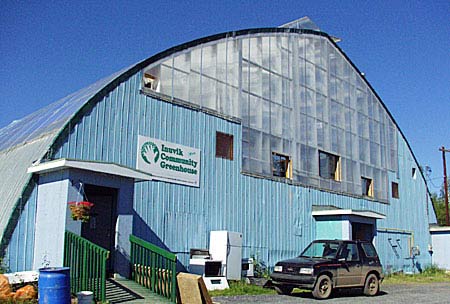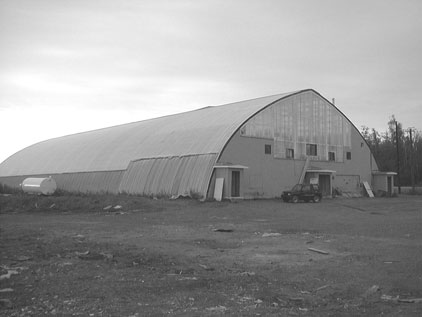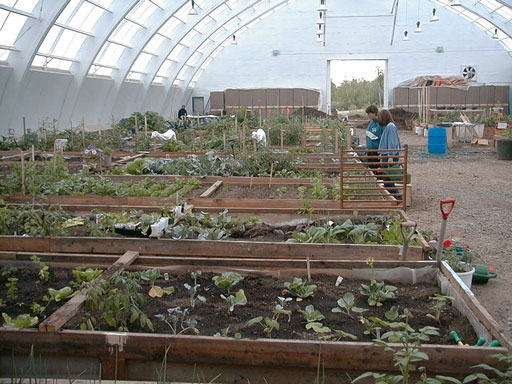Inuvik Community Greenhouse
Contact: Carrie Young
greenhouse@permafrost.com
Coordinator
Inuvik Community Greenhouse
Box 1544
Inuvik, NT
X0E 0T0
Hothouse flourishes as rink turns over new leaf
Vegetables, flowers -- even residents -- seem to thrive in Arctic community garden greenhouse
By JILL MAHONEY
Monday, Jul 12, 2004
The Globe and Mail
INUVIK, NWT -- Carrie Young is working on the second floor of an old hockey arena, dirt wedged under her cropped fingernails. Around her are containers of colourful geraniums, pansies and nasturtiums. Down below, there are carefully tended plots with rows of tender lettuce, silky cornstalks and broad strawberry plants.
This is the Inuvik Community Greenhouse, which, at 200 kilometres above the Arctic Circle, is thought to be the world's most northerly commercial operation and Canada's only community hothouse.
"It sounds cheesy, but it's a testimony of hope that you can do something if you want to, even in the frozen Arctic," said assistant co-ordinator Yoenne Ewald.
The rink, which belonged to Grollier Hall, the town's former residential school, was slated for demolition when a couple of locals formed a non-profit society in late 1998 to raise funds to transform the half-pipe-shaped arena into a greenhouse.
"They were just driving by one day and thinking, 'Oh, what a shame, what a waste of a building,' " said Ms. Young, the co-ordinator. "And they thought, 'Hey wait a minute, that'd be a really nice greenhouse.' "
The facility, which is in its fifth year of production, allows people who live in Inuvik, a one-stoplight town of about 3,700 in the northwest corner of the Northwest Territories, to grow their own vegetables under the midnight sun.
Summer student Brandi Lemishka's mother and her boyfriend have had a plot for three years, and tend produce such as the lettuce they have been eating for the past three weeks. "It's a lot better for them because then they don't have to go spend so much money on their food, because up here it costs a lot of money," said Ms. Lemishka, who enters Grade 11 in the fall.
At North Mart, Inuvik's grocery store, romaine lettuce was selling late last week for $3.79 a head. Small heads of iceberg lettuce were $1.79. Red peppers cost $6.21 a pound (0.45 kilograms) and broccoli was $2.59 a pound
For transplanted southern green thumbs such as Ms. Young and Ms. Ewald, the greenhouse also provides an outlet for the most un-Arctic of pastimes.
"I think it's a hobby for a lot of people that they didn't expect to be able to do up here," said Ms. Young, 32, who studied horticulture in her native Ottawa.
And, as Ms. Ewald, 24, who moved to the tundra of Inuvik from Victoria in April, said, the facility offers newcomers "a gentle way of easing into a new ecosystem."
For its more than 100 members, not all of whom have plots, the greenhouse, which opens in May, is a meeting place and "an oasis in the North," as Ms. Young put it. Families bring picnics or just pass the time soaking up the warmth and fragrant flowers. "It's always nice in here no matter what the weather is outside," she said.
The greenhouse, which receives funding from the territorial and federal governments, aboriginal groups and businesses, is also a community-development project that plays host to school groups, workshops and even tourists.
"It's amazing what can be grown on such a small square footage," said retiree Robert Harrison of Kingston, Ont., who toured the greenhouse with his wife Linda last week. "Square-inch gardening -- this is good," Ms. Harrison said.
The greenhouse is so popular there is a waiting list of residents eager to dig their fingers into its 88 raised plots, which are about 18 inches (46 centimetres) deep and can even nurture potatoes. The large ones are 16 by 4 feet (5 by 1 metres) and cost $50 a year to rent. The small ones, which are 8 by 4 feet (2.5 by 1 metres), are $25.
Many are thick with lush vegetables, from sprawling squash to onions to beets. One is even trying musk melon. A few have built-on supports for hanging flower baskets and latticework for climbing plants. One has delicate red, pink and white poppies. Some are whimsical, with a decorative scarecrow and a green smiling caterpillar. A few are neglected, with parched earth and stunted plants.
The greenhouse's growing season is like that in Southern Canada: from about the second week of May until early October, a stark contrast to outdoors. The last snowfall or frost in Inuvik is often in mid-June and starts again in late August.
The town's 24-hour daylight -- which lasts from about mid-May until mid-August and streams in through the roof's greenhouse glazing -- is a gardener's boon. One woman who keeps careful records says vegetables tend to mature one week to 10 days earlier.
But, as Ms. Young notes, the ever-present sunlight also has its drawbacks. If the weather is especially hot, the building can overheat and some vegetables, such as spinach, can go straight to seed. By contrast, if the weather is overcast for extended periods, tomatoes and other vegetables rot on the vine.
The greenhouse, which bans herbicides and pesticides, encourages its gardeners, who supply their own seeds, to add organic material to the poor-quality soil, which can have high sand or clay content. It does not prohibit the use of commercial fertilizers such as Miracle-Gro, but hopes to start a community compost program.
Update Report: September 20, 2002

The Inuvik Community Greenhouse is now wrapping up its third season of operation. With the combined efforts of the Community Garden Society's 100 plus members and our supporters we can say with confidence that our project has experienced unequaled success. We have established ourselves as a volunteer force and are proud to have had an entirely positive effect in the community.
Since its inception in November of 1998, the Community Garden Society has managed to raise funds to renovate the old Grollier Hall Arena into a community and commercial greenhouse and see it into full production by the spring of 2000. This year we have expanded our bedding plant production and have a waiting list of people eager to secure themselves a garden plot in the community area.
The Inuvik Community Greenhouse is the most northerly commercial greenhouse operation and the only greenhouse of its kind in Canada. The building houses two areas: raised community garden plots on the main floor and a small commercial greenhouse on a second floor. The garden plots are available to Inuvik residents and some are reserved for Elders and other community groups. The commercial greenhouse produces bedding plants (flowers and starter veggie plants) and also a crop of tomatoes and English cucumbers. There are also rooms in the building for storage, office for staff and a classroom for workshops and gardening classes.
The Community Garden Society raises funds for the operation costs of the greenhouse through government funding (both federal and territorial), local business support, volunteer run bingos/ yard sales/raffles, and the sale of bedding plants. We were very pleased to have receive a donation from Chevron/Texaco Canada of $30,000 in 2001 that we have used for renovations on the building and operation costs.
Community gardening is quickly becoming a solution for urban people to grow their own food on a small scale who lack space on their own property or gardening experience. This is especially true for residents of Inuvik who, even if they own property, have permafrost and a very short (and unpredictable) growing season to contend with. Growing indoors and in raised planters makes it possible to produce high quality produce in the North. This is important in Inuvik where the variety and quantity of produce available is limited. High transportation costs and great distances result in expensive and often poor quality produce.
The community greenhouse has, over the last three years, provided opportunities for both recreational gardening/ food production and building a strong sense of community through member support and sharing of knowledge. We have also provided learning opportunities through various workshops, kids gardening classes, work placements for "Inuvik Works" candidates and a composting project that we hope will involve the community.
The greenhouse has also been involved in town beautification efforts over the last three years. We provide the hanging baskets for the main street flower program and continue to prepare window boxes for the Inuvik Housing Authority to put on their houses. We have also provided flowers and planters for local businesses. This, combined with all the bedding plants we sell to local residents, makes the Town of Inuvik more appealing to locals and to tourists.

First Report:
The Inuvik Community Greenhouse is located in Inuvik, Northwest Territories, just above the 68th parallel, roughly 2 degrees north of the Arctic Circle. It is home to the Community Garden Society of Inuvik- a non-profit organisation formed in November of 1998. We are the most Northern commercial greenhouse in North America and the largest community greenhouse of it's kind on the planet.
The greenhouse itself is an old Quonset style arena that has been converted by removing the tin roof and replacing it with polycarbonate glazing. The arena had been slated for demolition along with the residential school adjacent to it. A second floor was added to one end of the building and a separate upper greenhouse was build for commercial purposes. This commercial greenhouse is approximately 4000 square feet. The remaining part of the greenhouse is main floor (on gravel) and is about 12,000 square feet. A ridge vent runs along the length of the roof and is set up to open automatically. Raised planter beds were build on top of the gravel floor. These beds are rented to Garden Society members for a nominal annual fee. Plots are 16 feet long 5 feet wide and 2 feet tall. The beds have a layer of insulation in the bottom to keep out permafrost. There are 74 plots in total. Many of the plot fees are sponsored by local businesses for Elders and youth.
The greenhouse has served as a focal point for community development. It has attracted people from a very wide scope: experienced gardeners, new gardeners, old, young and a wide variety of ethnic backgrounds including a significant interest from the 2 local aboriginal peoples- the Gwich'in and Inuvialuit. The purpose of the greenhouse was to ensure a more successful harvest of vegetables and to allow a greater variety of crops in an area where fresh and economical produce is often unavailable.

The summer of 2000 was our first year of full operation for the greenhouse. The commercial greenhouse, staffed with 2 employees, produced a large crop of bedding plants and starter veggie plants for early June sales. This was a great success and the Town of Inuvik looked more beautiful than ever. As the bedding plants moved out, the commercial greenhouse shifted to hydroponic tomato and cucumber production. This was less of a success, but did show promise for future years as the bugs in the climate control systems get worked out. Downstairs, in the community plots, people were planting out as early as the first weekend of May and gardened until the beginning of September. That, coupled with our 24 hour sunlight, we've at least got a growing season indoors similar to that of southern Alberta.
The growing season is over for this year and we're just shutting down and cleaning up for next year. We'll keep you posted! Thanks for your interest.
Pass your exam 70-620 on first try using 70-649 vce practices questions and exam 70-680 prepared by certified experts to provide you guaranteed success; they also prepare 70-516 pdf & 70-511 pdf resources with full devotion.

